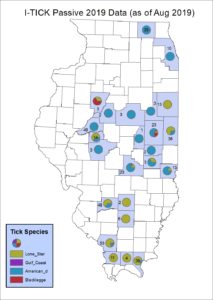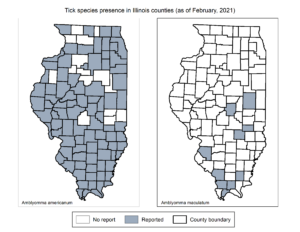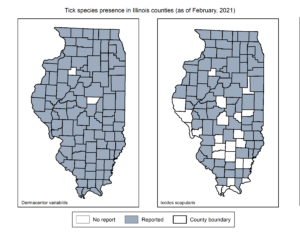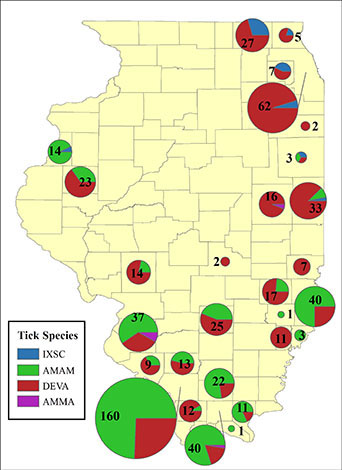INFORMATION AND RESULTS
Reported Species Distribution Maps
The four maps below show where the main vector tick species (blacklegged tick, Lone star tick, American dog tick, or Gulf Coast tick) has been reported within Illinois. This means that at least one tick of that species has been found in the county (it does not necessarily mean that species is established and reproducing in the county).
2019 Results (as of July 26, 2019)
- I-TICK Kits (Passive Surveillance)
- The second year is off to a great start! Participation in the I-TICK program is growing with 51 public hubs, and 24 private hubs.
- I-TICK has launched its social media campaign on May 24, 2019. We are now reaching the public through Facebook, Instagram, and Twitter. As of June 5, 2019 our social media presence has reached over 800 people in the first two weeks.
- Tick species and life stage identification is complete for I-TICK kits returned to us by July 9, 2019.
Table 1: Summary of species and life stage for 2019 I-TICK Hub Collections (as of August, 2019)
| Species | Adult | Nymph | Larva* | Total |
|---|---|---|---|---|
| Amblyomma americanum (Lone Star) |
123 | 62 | Not Available | 185 |
| Amblyomma maculatum (Gulf Coast) | 1 | 0 | Not Available | 1 |
| Dermacentor variabilis (American Dog) | 148 | 0 | Not Available | 148 |
| Ixodes Scapularis (Deer/Blacklegged) | 5 | 0 | Not Available | 5 |
| Grand Total | 277 | 62 | Not Available | 339 |
*Larva numbers are estimated

Please click on the image for full sized view. A map showing the counties where passive surveillance tick data has been gathered through I-TICK kits in 2019.
- I-TICK Tick Dragging (Active Surveillance)
- As part of our active surveillance, I-TICK conducts bi-weekly tick dragging in two counties and once a month “blitzes” in southern Illinois. Specific county health departments may also conduct their own active tick dragging surveillance and submit their findings to I-TICK.
Table 2: Summary of species and life stage for 2019 I-TICK Active Surveillance (as of December 31, 2019)
I-TICK Researchers are carrying out tick dragging in Douglas and Moultrie counties. The status of I. scapularis is unknown in these counties. Through our active surveillance we hope to determined what ticks are established or present in these two counties. Our southern Illinois “blitzes” take place in Hamilton, Jackson, Jefferson, Perry, Pope, and Williamson counties once a month. St. Clair County Health Department conducted their own tick dragging and submitted ticks found to I-TICK.
| Species | Adult | Nymph | Larva* | Total |
|---|---|---|---|---|
| Amblyomma americanum (Lone Star) |
106 | 367 | 346 | 819 |
| Amblyomma maculatum (Gulf Coast) | 1 | 0 | Not Available | 1 |
| Dermacentor variabilis (American Dog) | 223 | 1 | Not Available | 224 |
| Ixodes scapularis (Deer/Blacklegged) | 5 | 8 | Not Available | 13 |
| Grand Total | 335 | 376 | 346 | 1057 |
2018 Results (as of December 31st, 2018)
- I-TICK Kits (Passive Surveillance)
- The first year was overwhelmingly successful: 70 individual participants and 18 Hubs collected over 900 ticks in 28 counties.
- Tick species and life stage identification is complete for 2018 (Table 1)
Table 1: Summary of species and life stage for 2018 I-TICK Hub Collections
| Species | Adult | Nymph | Larva* | Total |
|---|---|---|---|---|
| Amblyomma americanum (Lone Star) |
150 | 137 | 284 | 571 |
| Amblyomma maculatum (Gulf Coast) | 5 | 0 | 0 | 5 |
| Dermacentor variabilis (American Dog) | 307 | 0 | 0 | 307 |
| Ixodes scapularis (Blacklegged) | 12 | 6 | 0 | 18 |
| Grand Total | 474 | 143 | 284 | 901 |
*Larva numbers are estimated



